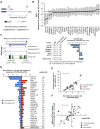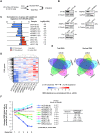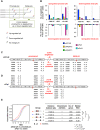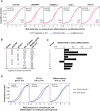Systematic profiling of poly(A)+ transcripts modulated by core 3' end processing and splicing factors reveals regulatory rules of alternative cleavage and polyadenylation
- PMID: 25906188
- PMCID: PMC4407891
- DOI: 10.1371/journal.pgen.1005166
Systematic profiling of poly(A)+ transcripts modulated by core 3' end processing and splicing factors reveals regulatory rules of alternative cleavage and polyadenylation
Abstract
Alternative cleavage and polyadenylation (APA) results in mRNA isoforms containing different 3' untranslated regions (3'UTRs) and/or coding sequences. How core cleavage/polyadenylation (C/P) factors regulate APA is not well understood. Using siRNA knockdown coupled with deep sequencing, we found that several C/P factors can play significant roles in 3'UTR-APA. Whereas Pcf11 and Fip1 enhance usage of proximal poly(A) sites (pAs), CFI-25/68, PABPN1 and PABPC1 promote usage of distal pAs. Strong cis element biases were found for pAs regulated by CFI-25/68 or Fip1, and the distance between pAs plays an important role in APA regulation. In addition, intronic pAs are substantially regulated by splicing factors, with U1 mostly inhibiting C/P events in introns near the 5' end of gene and U2 suppressing those in introns with features for efficient splicing. Furthermore, PABPN1 inhibits expression of transcripts with pAs near the transcription start site (TSS), a property possibly related to its role in RNA degradation. Finally, we found that groups of APA events regulated by C/P factors are also modulated in cell differentiation and development with distinct trends. Together, our results support an APA code where an APA event in a given cellular context is regulated by a number of parameters, including relative location to the TSS, splicing context, distance between competing pAs, surrounding cis elements and concentrations of core C/P factors.
Conflict of interest statement
The authors have declared that no competing interests exist.
Figures








Similar articles
-
Transcription elongation rate has a tissue-specific impact on alternative cleavage and polyadenylation in Drosophila melanogaster.RNA. 2017 Dec;23(12):1807-1816. doi: 10.1261/rna.062661.117. Epub 2017 Aug 29. RNA. 2017. PMID: 28851752 Free PMC article.
-
Alternative cleavage and polyadenylation in spermatogenesis connects chromatin regulation with post-transcriptional control.BMC Biol. 2016 Jan 22;14:6. doi: 10.1186/s12915-016-0229-6. BMC Biol. 2016. PMID: 26801249 Free PMC article.
-
Systematic identification of functional SNPs interrupting 3'UTR polyadenylation signals.PLoS Genet. 2020 Aug 17;16(8):e1008977. doi: 10.1371/journal.pgen.1008977. eCollection 2020 Aug. PLoS Genet. 2020. PMID: 32804959 Free PMC article.
-
Implications of polyadenylation in health and disease.Nucleus. 2014;5(6):508-19. doi: 10.4161/nucl.36360. Epub 2014 Oct 31. Nucleus. 2014. PMID: 25484187 Free PMC article. Review.
-
Regulation and function of alternative polyadenylation in development and differentiation.RNA Biol. 2023 Jan;20(1):908-925. doi: 10.1080/15476286.2023.2275109. Epub 2023 Oct 31. RNA Biol. 2023. PMID: 37906624 Free PMC article. Review.
Cited by
-
Alternative polyadenylation of mRNA precursors.Nat Rev Mol Cell Biol. 2017 Jan;18(1):18-30. doi: 10.1038/nrm.2016.116. Epub 2016 Sep 28. Nat Rev Mol Cell Biol. 2017. PMID: 27677860 Free PMC article. Review.
-
A missense mutation in the CSTF2 gene that impairs the function of the RNA recognition motif and causes defects in 3' end processing is associated with intellectual disability in humans.Nucleic Acids Res. 2020 Sep 25;48(17):9804-9821. doi: 10.1093/nar/gkaa689. Nucleic Acids Res. 2020. PMID: 32816001 Free PMC article.
-
Dynamic Variations of 3'UTR Length Reprogram the mRNA Regulatory Landscape.Biomedicines. 2021 Oct 28;9(11):1560. doi: 10.3390/biomedicines9111560. Biomedicines. 2021. PMID: 34829789 Free PMC article. Review.
-
Distal Alternative Last Exons Localize mRNAs to Neural Projections.Mol Cell. 2016 Mar 17;61(6):821-33. doi: 10.1016/j.molcel.2016.01.020. Epub 2016 Feb 18. Mol Cell. 2016. PMID: 26907613 Free PMC article.
-
Alternative polyadenylation of mRNA and its role in cancer.Genes Dis. 2019 Oct 25;8(1):61-72. doi: 10.1016/j.gendis.2019.10.011. eCollection 2021 Jan. Genes Dis. 2019. PMID: 33569514 Free PMC article. Review.
References
-
- Colgan DF, Manley JL. Mechanism and regulation of mRNA polyadenylation. Genes Dev. 1997;11(21):2755–66. - PubMed
MeSH terms
Substances
Associated data
- Actions
Grants and funding
LinkOut - more resources
Full Text Sources
Other Literature Sources
Molecular Biology Databases
Miscellaneous

